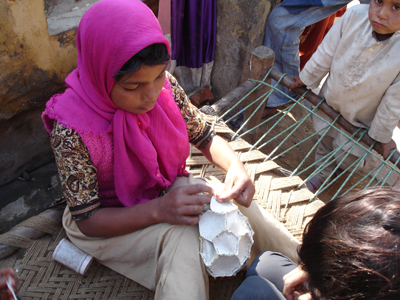
World Vision Australia’s SACHA MYERS writes about why we should think about where our soccer balls come from…
With the World Cup in full swing, fans across Australia are glued to their TV sets enjoying the thrills, spills and drama of the biggest global sporting event since the Olympics. But sadly, on a recent trip to India, World Vision discovered it’s not all fair play when it comes to soccer balls.
Most of the world’s soccer balls are hand-stitched in countries where worker conditions are questionable at best. Most balls branded Nike and adidas are made in Pakistan and India, which together produce 90 per cent of the world’s hand-stitched soccer balls.

WHERE DOES YOUR SOCCER BALL COME FROM? Children stitch soccer balls in Meerut, India, for the domestic market. PICTURE: Courtesy World Vision Australia.
“During this year’s FIFA World Cup World Vision is calling on the big sporting companies to make sure their supply chains are transparent, traceable and independently verifiable to ensure that they are free from all child and exploited labour.”
– Susan Mizrahi, Don’t Trade Lives campaign leader
World Vision’s Don’t Trade Lives campaign leader Susan Mizrahi said while there had been some big improvements in how soccer balls were made for the export industry, there was still a risk that child labour was used to make sports balls.
“Over the last 10 years, export manufacturers have been under intense international scrutiny to clean up their supply chains and eradicate child labour. In 2006, Nike severed its ties with its soccer balls manufacturer, Saga Sport, for violating Nike’s own code of conduct relating to child labour,” she said.
“While there have been some huge improvements, our concern is that when manufacturers get more orders than their stitching centres can handle, they outsource to contractors who then give the raw materials to families in villages to stitch together. It’s at this point that even the big brands can lose control of their supply chains.”
The demand for soccer ball production in Pakistan alone reportedly increases from 40 million balls to 60 million balls during a World Cup year.
“During this year’s FIFA World Cup World Vision is calling on the big sporting companies to make sure their supply chains are transparent, traceable and independently verifiable to ensure that they are free from all child and exploited labour,” Ms Mizrahi said.
“Consumers have a role to play too. While the balls we kick around in Australia are most likely not made using child labour, it’s still really important that consumers are aware of the issue. Australians who buy soccer balls should make sure the company who makes the ball has an anti-child labour policy.”
On a recent trip to India, Ms Mizrahi visited Meerut and talked with children who did not go to school and instead stitched soccer balls for India’s domestic market for as little as seven Australian cents per ball.
The children said they often sustained septic cuts to their fingers and suffered chronic back, neck and leg pain from sitting in a hunched position for hours at a time.
“I took a family up on their suggestion that I try to stitch a ball,” Ms Mizrahi said. “A stitcher sits in a crouched position to hold the patches of fabric tight between their knee-caps. The thread is tough and not easily pulled, unlike cotton or wool. I can imagine that sewing a ball on the odd occasion would not be too difficult. To work in this position for multiple hours, however, and especially for a child, would be an unpleasant experience to say the least – the very least.”
The situation Ms Mizrahi found in the district of Jalandhar in India, where soccer balls for the export market are made, was very different. Child stitchers in Jalandhar mostly work after school or on weekends and earned up to 75 Australian cents per ball.
“The better working conditions in Jalandhar shows there have been positive changes in how soccer balls are made for the export industry. However, we can’t assume that children who make balls for the export industry are totally free from exploitation,” Ms Mizrahi said.
So as you set up camp in front of the TV in your Socceroos jumper, remember the connection between soccer and child labour. You can act now to kick child labour out of soccer balls visit www.worldvision.com.au/donttradelives for more information or ask your favourite sports company what its policy on child labour is at www.chainstorereaction.com.au.
Sacha Myers is a media officer at World Vision Australia.





